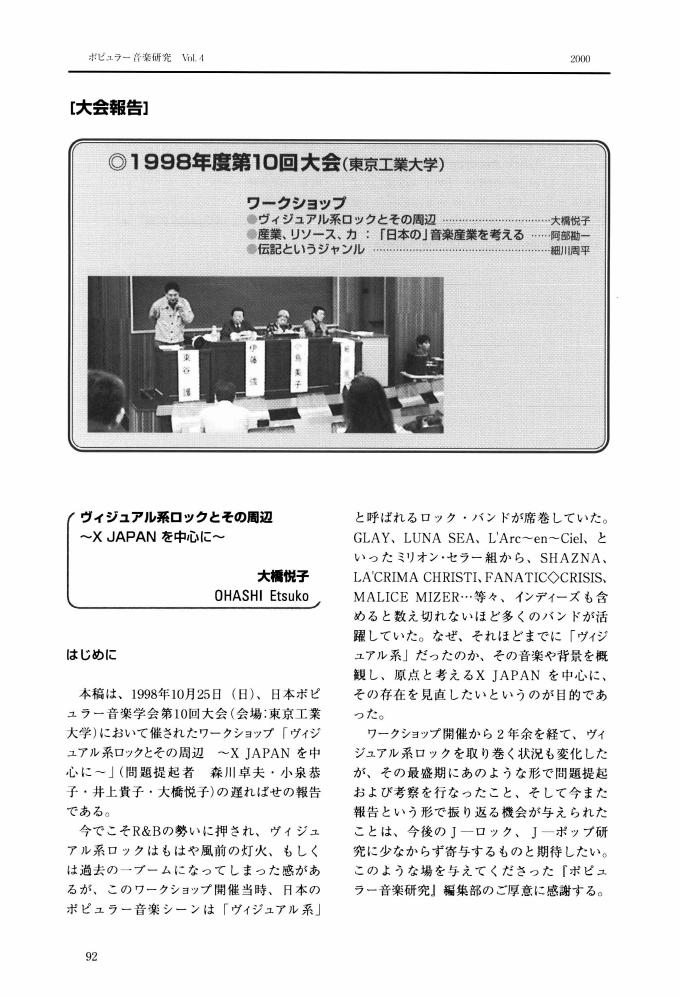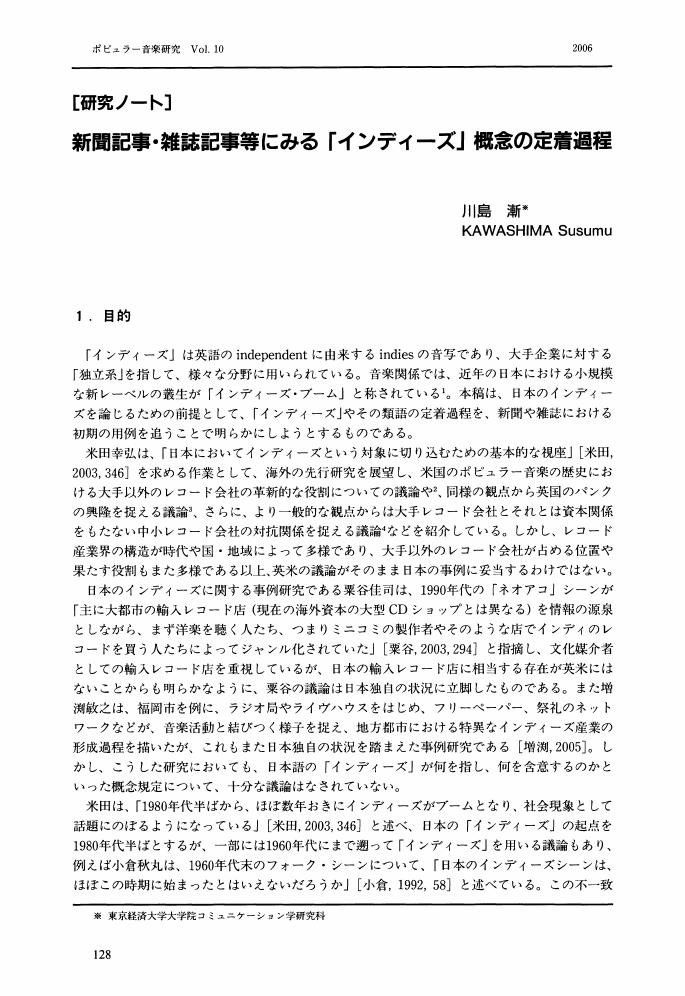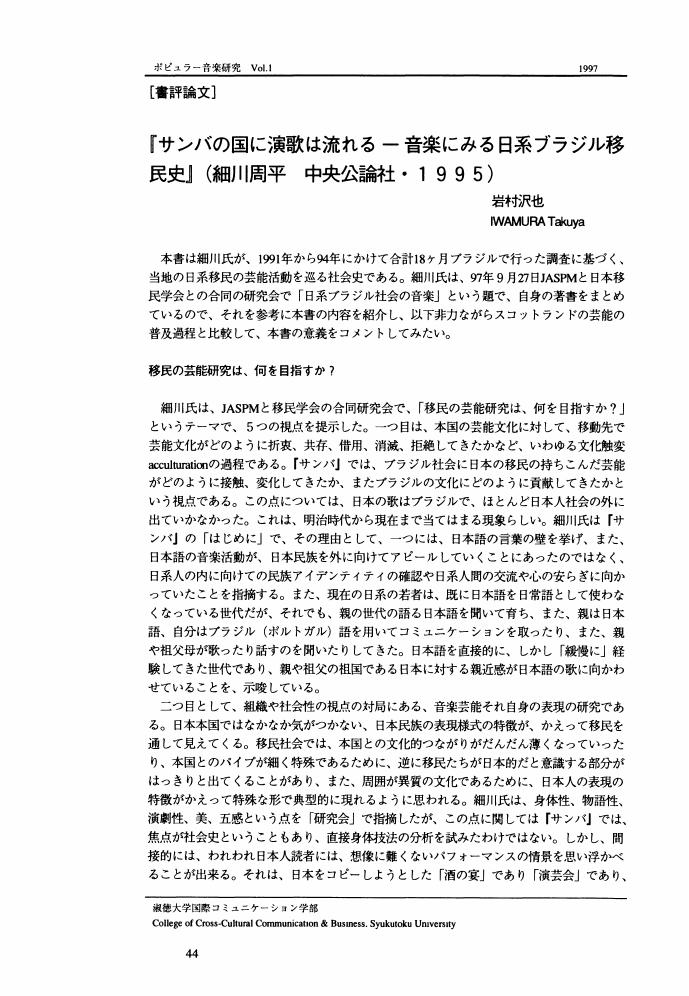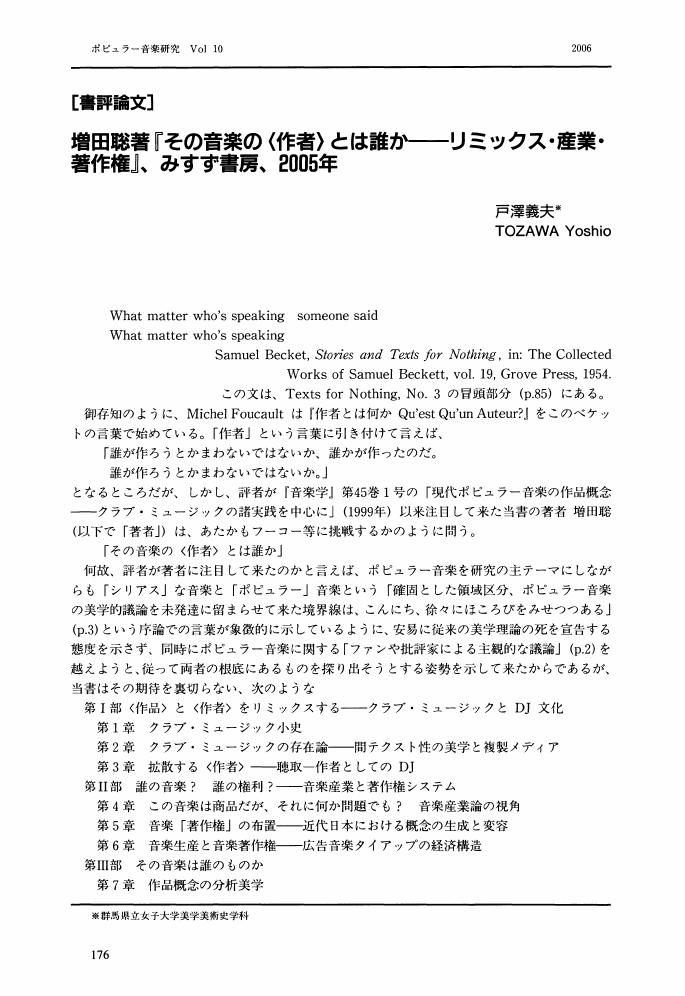- 著者
- 永井 純一
- 出版者
- The Japanese Association for the Study of Popular Music
- 雑誌
- ポピュラー音楽研究 (ISSN:13439251)
- 巻号頁・発行日
- vol.10, pp.96-111, 2006
近年、ロックフェスティバルをはじめとする音楽イベントが隆盛である。それらは、かつてのようにカウンターカルチャーの決起集会的なものではなく、レジャー感覚で楽しむものとして定着しつつある。そこでは、ポピュラー音楽の新たな受容のスタイルが生み出されている。このとき聴衆は「参加者」として新たな意味が付与され、主催者とともにフェスティバルを作り上げるような、積極的な存在として捉えられている。音楽受容が多様化するなか、こうした現象はポピュラー音楽研究のさまざまな観点から論じられるべき、興味深い現象であるといえよう。本報告では彼らのエスノグラフィ通じて、現代の積極的な聴衆としてのロックフェスティバルの参加者像を描くことを目的とする。
4 0 0 0 OA [書評論文] 阿部勘一編著「ブラスバンドの社会史」
- 著者
- 大山 昌彦
- 出版者
- The Japanese Association for the Study of Popular Music
- 雑誌
- ポピュラー音楽研究 (ISSN:13439251)
- 巻号頁・発行日
- vol.6, pp.73-83, 2002 (Released:2009-10-29)
- 参考文献数
- 9
- 著者
- 中河 伸俊
- 出版者
- The Japanese Association for the Study of Popular Music
- 雑誌
- ポピュラー音楽研究 (ISSN:13439251)
- 巻号頁・発行日
- vol.7, pp.52-61, 2003 (Released:2009-10-29)
- 参考文献数
- 8
3 0 0 0 OA ロックの「時代精神」からオーディエンスへ
- 著者
- 粟谷 佳司
- 出版者
- The Japanese Association for the Study of Popular Music
- 雑誌
- ポピュラー音楽研究 (ISSN:13439251)
- 巻号頁・発行日
- vol.2, pp.23-34, 1998-11-30 (Released:2009-10-29)
- 参考文献数
- 45
This paper examines the politics of discourse on the value of ‘rock’ by critics and academics and importance of audience, mostly neglect in those discourses. First of all, the discourse on ‘the end of the rock era’ by Simon Frith reveals that it stands on ambivalent attitudes towards authenticity of music, which should have been rejected by the thechnology. Then we investigatethe reason why appropriation of musical meaning of audiences which in spite of it's importance, its negrected by Frith and only discribed negatively at the mass society theory is so important by the framework after the rise of Cultural Studies.
3 0 0 0 OA 沖縄音楽レコード制作における〈媒介者〉としての普久原朝喜
- 著者
- 高橋 美樹
- 出版者
- The Japanese Association for the Study of Popular Music
- 雑誌
- ポピュラー音楽研究 (ISSN:13439251)
- 巻号頁・発行日
- vol.10, pp.58-79, 2006 (Released:2009-10-29)
- 参考文献数
- 47
本稿の目的は1920-40年代に沖縄出身の普久原朝喜が丸福レコードにおける〈媒介者〉として、どのような実践をしていたのか明らかにすることである。制作者としての役割を果たしながら、歌手・演奏家、聴衆を仲介する人物として、朝喜の実践を分析した。結論は以下の3点である。第1に、朝喜はレコードを沖縄、日本、海外における沖縄系エスニック・コミュニティに向けて発信するスタイル、つまり〈内向き〉発信スタイルに基づきレコードを発売していた。第2に、レコード制作は沖縄固有のローカル性に富み、聴衆と販路は国境を越え流動化していた。ただし、丸福レコードの活動は国という地理的な境界は越えたが、沖縄人という民族的な境界は越えていなかった。第3に、大阪在住の朝喜の存在は沖縄移民の中継地として機能していた。朝喜は沖縄、日本、海外における沖縄系ネットワークを有効に活用し、レコード制作販売に反映させることで商業的成功を成し遂げたといえる。
3 0 0 0 国内地方都市における音楽の産業化週程-福岡市の場合
- 著者
- 増淵 敏之
- 出版者
- 日本ポピュラー音楽学会
- 雑誌
- ポピュラー音楽研究 (ISSN:13439251)
- 巻号頁・発行日
- no.9, pp.3-21, 2005
- 被引用文献数
- 1
近年、ようやく国内においてもインディーズの台頭により、地方都市でも産業化の可能性が見えてきた。まず沖縄県がモンゴル800のヒットから次々に成功事例を作り、行政までが産業育成に具体的に乗り出してきている。戦後、国内の音楽産業は長く東京一極集中の状態にあった。しかし様々な要因によって国内の市場規模が縮小する中、地方への分散はひとつの打開策として検討されるべきだろう。それが産業化の前段として、音楽を改めて地域の文化として捉え直すことなのである。本論文は、地方都市における音楽文化の発展の過程について、福岡市を事例に検討する。そして地域の音楽文化が産業化していくための基盤を明らかにする。
3 0 0 0 OA 「非-芸人」としてのストリートミュージシャン-「他者」の機能を中心に-
- 著者
- 井手口 彰典
- 出版者
- The Japanese Association for the Study of Popular Music
- 雑誌
- ポピュラー音楽研究 (ISSN:13439251)
- 巻号頁・発行日
- vol.8, pp.3-16, 2004-12-28 (Released:2009-10-29)
- 参考文献数
- 22
- 被引用文献数
- 1
筆者の考えによれば、いわゆる「ストリートミュージシャン」という言葉によって示される対象は、特に90年代後半からの日本において大きく変質してきている。旧来的には当然であった「芸を演じる」という感覚を持ち合わせない者たちが出現しているのだ。しかしそのような変質に着目する研究的視点は未だ少なく、旧来的なストリートミュージシャン像との間に混乱をきたしている。本論文は、近年現れた「非-芸人」とでも呼びうる新たなストリートミュージシャンを、特に他者との関係性から分析し、旧来的なものとは区分して捉える重要性を提言する。またそのような異質なストリートミュージシャンたちが現れてきた背景を明らかにし、その活動が生み出される機制を考察する。
- 著者
- 東谷 護
- 出版者
- The Japanese Association for the Study of Popular Music
- 雑誌
- ポピュラー音楽研究 (ISSN:13439251)
- 巻号頁・発行日
- vol.3, pp.24-29, 1999
2 0 0 0 OA 中部タイ農村部における民謡と大衆歌謡の相互作用的発展
- 著者
- 鶴田 格
- 出版者
- The Japanese Association for the Study of Popular Music
- 雑誌
- ポピュラー音楽研究 (ISSN:13439251)
- 巻号頁・発行日
- vol.4, pp.2-19, 2000 (Released:2009-10-29)
- 参考文献数
- 16
This paper examines the interlocking development processes of rural folk songs and luuk thung, a genre of popular music which developed under the considerable influence of folk musical traditions in Central Thailand.With the drastic socioeconomic changes which occurred in the 1960s, folk song genres in Central Thailand, including phleeng iisaew, gradually declined and were finally replaced by modern entertainment, such as luuk thung. Khwancit Siipracan, a competent folk singer at that time, left her home village for Bangkok to become a luuk thung singer in the late 1960s and recorded a number of popular songs with an identifiable local flavor. In the late 1970s, Khwancit established her own folk entertainment troupe and succeeded in commercializing phleeng iisaew by modernizing the style of performance for contemporary audiences. This fact indicates that, during the period from the 1960s to 1980s, popular music (including commercialized folk songs) in Central Thailand developed on the basis of the direct interplay between rural folk songs and urban popular songs.
2 0 0 0 OA 国内地方都市における音楽の産業化週程-福岡市の場合
- 著者
- 増淵 敏之
- 出版者
- The Japanese Association for the Study of Popular Music
- 雑誌
- ポピュラー音楽研究 (ISSN:13439251)
- 巻号頁・発行日
- vol.9, pp.3-21, 2005 (Released:2009-10-29)
- 参考文献数
- 46
- 被引用文献数
- 1
近年、ようやく国内においてもインディーズの台頭により、地方都市でも産業化の可能性が見えてきた。まず沖縄県がモンゴル800のヒットから次々に成功事例を作り、行政までが産業育成に具体的に乗り出してきている。戦後、国内の音楽産業は長く東京一極集中の状態にあった。しかし様々な要因によって国内の市場規模が縮小する中、地方への分散はひとつの打開策として検討されるべきだろう。それが産業化の前段として、音楽を改めて地域の文化として捉え直すことなのである。本論文は、地方都市における音楽文化の発展の過程について、福岡市を事例に検討する。そして地域の音楽文化が産業化していくための基盤を明らかにする。
2 0 0 0 OA 路上演奏者の公共感覚
- 著者
- 木島 由晶
- 出版者
- The Japanese Association for the Study of Popular Music
- 雑誌
- ポピュラー音楽研究 (ISSN:13439251)
- 巻号頁・発行日
- vol.10, pp.16-39, 2006 (Released:2009-10-29)
- 参考文献数
- 20
- 被引用文献数
- 2
近年の路上演奏は、都市部における青年文化の文脈で捉えられやすい。本稿はこの観点を継承し、大阪有数の都市である心斎橋周辺をモデル・ケースとして、路上文化の今日的な様相を示す。分析の前半では、169名分のインタビュー・データを整理して演者の意識の傾向を把握する。これをふまえて後半では、フィールド・リサーチの知見を導入して路上文化の特色を位置づける。以上の分析から得られた知見は、つぎの3点である。(1)路上文化が定着した要因には、通行人に対する意識の低下よりも、路上に対する安心感の高まりが大きい。(2)路上で自由に演奏してもよいという感覚は、今日では演者当人をこえて、演者をとりまく警察や自治体の側に波及している。(3)こうした状況の変化は、演者の二極化傾向を促進させる。一方は、通行人を意識しないで気ままに演奏を楽しむスタイルであり、他方は、通行人を強く意識してレコード・デビューを目指すスタイルである。
2 0 0 0 OA 日本におけるラップ実践と人的ネットワーク
- 著者
- 木本 玲一
- 出版者
- The Japanese Association for the Study of Popular Music
- 雑誌
- ポピュラー音楽研究 (ISSN:13439251)
- 巻号頁・発行日
- vol.7, pp.3-14, 2003 (Released:2009-10-29)
- 参考文献数
- 28
- 被引用文献数
- 1
This article examines the networks of people that mediate local rap music in Japan. By focusing on two local rap groups, it explores how they utilize these networks in their live performances and in the releases of their songs. It argues that such networks tend to be constructed in nightclubs and this tendency is connected to the sub-cultural values found on the Japanese rap music scene.
2 0 0 0 OA JASPM10大会報告
- 出版者
- 日本ポピュラー音楽学会
- 雑誌
- ポピュラー音楽研究 (ISSN:13439251)
- 巻号頁・発行日
- vol.4, pp.92-101, 2000 (Released:2009-10-29)
2 0 0 0 OA 〈参加〉する聴衆-フジロックフェスティバルにおけるケーススタディ-
- 著者
- 永井 純一
- 出版者
- The Japanese Association for the Study of Popular Music
- 雑誌
- ポピュラー音楽研究 (ISSN:13439251)
- 巻号頁・発行日
- vol.10, pp.96-111, 2006 (Released:2009-10-29)
- 参考文献数
- 29
近年、ロックフェスティバルをはじめとする音楽イベントが隆盛である。それらは、かつてのようにカウンターカルチャーの決起集会的なものではなく、レジャー感覚で楽しむものとして定着しつつある。そこでは、ポピュラー音楽の新たな受容のスタイルが生み出されている。このとき聴衆は「参加者」として新たな意味が付与され、主催者とともにフェスティバルを作り上げるような、積極的な存在として捉えられている。音楽受容が多様化するなか、こうした現象はポピュラー音楽研究のさまざまな観点から論じられるべき、興味深い現象であるといえよう。本報告では彼らのエスノグラフィ通じて、現代の積極的な聴衆としてのロックフェスティバルの参加者像を描くことを目的とする。
2 0 0 0 OA 新聞記事・雑誌記事等にみる「インディーズ」概念の定着週程
- 著者
- 川島 漸
- 出版者
- 日本ポピュラー音楽学会
- 雑誌
- ポピュラー音楽研究 (ISSN:13439251)
- 巻号頁・発行日
- vol.10, pp.128-142, 2006 (Released:2009-10-29)
- 参考文献数
- 16
- 著者
- 岩村 沢也
- 出版者
- 日本ポピュラー音楽学会
- 雑誌
- ポピュラー音楽研究 (ISSN:13439251)
- 巻号頁・発行日
- vol.1, pp.44-52, 1997-11-30 (Released:2009-10-29)
2 0 0 0 Pan in Japan:日本におけるスティールパンの受容と普及
- 著者
- 冨田 晃
- 出版者
- 日本ポピュラー音楽学会
- 雑誌
- ポピュラー音楽研究 (ISSN:13439251)
- 巻号頁・発行日
- vol.5, pp.18-36, 2001
This is a monograph on steelpan history in Japan for the past thirty years. Steelpan, a melodious percussion instrument made from oil-drums, was invented and developed in Trinidad and Tobago. Study of musical instruments within a traditional ethnomusicological approach aims to clarify the society where a particular instrument is invented and developed. However, with new directions in the study of musical instruments, this article aims to clarify the society where an instrument is accepted and diffused, paying particular attention to the phenomenon of displacement. Considering the World Music Boom to be a border between different periods, the author divides the history into “Period of Professionals (about 1970-1989)” and “Period of Amateurs (after 1990).” On this basis, the Japanese use of steelpan is discussed in terms of the social frameworks, images and technologies that exist.
2 0 0 0 OA [書評論文] 井上貴子著『近代インドにおける音楽学と芸能の変容』、青弓社、2006年
- 著者
- 田井 竜一
- 出版者
- 日本ポピュラー音楽学会
- 雑誌
- ポピュラー音楽研究 (ISSN:13439251)
- 巻号頁・発行日
- vol.10, pp.171-175, 2006 (Released:2009-10-29)
- 著者
- 戸澤 義夫
- 出版者
- 日本ポピュラー音楽学会
- 雑誌
- ポピュラー音楽研究 (ISSN:13439251)
- 巻号頁・発行日
- vol.10, pp.176-180, 2006 (Released:2009-10-29)
- 著者
- 今田 匡彦
- 出版者
- 日本ポピュラー音楽学会
- 雑誌
- ポピュラー音楽研究 (ISSN:13439251)
- 巻号頁・発行日
- vol.10, pp.163-170, 2006 (Released:2009-10-29)
- 参考文献数
- 4







